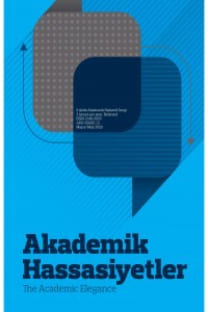MICHAEL E. PORTER VE JAY BARNEY’İN REKABET ÜSTÜNLÜĞÜ İLE İLGİLİ YAKLAŞIMLARININ DEĞERLENDİRİLMESİ
Michael E. Porter, Jay Barney, Rekabet, Rekabet Üstünlüğü
EVALUATION OF MICHAEL E. PORTER AND JAY BARNEY'S APPROACHES TO COMPETITIVE ADVANTAGE
___
- Açıkgöz, B. (2012). “Stratejik İnsan Kaynakları Yönetimine Aşamalı Bir Bakış: Strateji, Sürdürülebilir Rekabetçi Üstünlük ve Kaynak Tabanlı Yaklaşımın Kesişme Noktası”, İş, Güç Endüstri İlişkileri ve İnsan Kaynakları Dergisi, 14/4, ss.107-130.
- Barca, M. - Esen, Ş. (2012). “Rekabet Avantajı Sağlama ve Sürdürmede Stratejik Yaklaşımlar”, e-Journal of New World Sciences Academy, Volume: 7, Number:2, pp.89-107.
- Barney, J. (1986a). “Organizational Culture: Can it be a Source of Sustained Competitive Advantage?”, Academy of Management Review, 11/3, ss. 656 – 665.
- Barney, J. (1986b). “Types of Competition and The Theory of Strategy: Toward An Integrative Framework”, Academy of Management Review, 11/4, ss. 791 – 800.
- Barney, J., McWilliams, A. - Turk, T. (1989). “On the Relevance of the Concept of Entry Barriers in the Theory of Competitive Strategy”. Paper Presented at the Annual Meeting of the Strategic Management Society, San Francisco.
- Barney, J. (1991). “Firm Resources and Sustained Competitive Advantage”, Journal of Management, Vol. 17, No.1, ss. 99 – 120.
- Barney, J. (2014). Gaining and Sustaining Competitive Advantage, Fourth Edition, Harlow, Essex: Pearson Education Limited.
- Barney, J. B. - Clark, D. N. (2007). Resource-Based Theory Creating and Sustaining Competitive Advantage, New York: Oxford University Press.
- Dursun, İ. T. (2007). Stratejik Yönetim Yaklaşımları Açısından Sektör Analizi: Seramik Kaplama Malzemeleri Sektörü Örneği, Yayınlanmamış Yüksek Lisans Tezi, Sakarya Üniversitesi.
- El Shafeey, T. - Trott, P. (2014). “Resource-Based Competition: Three Schools of Thought and Thirteen Criticisms”, European Business Review, Vol.26, No.2, pp. 122-148.
- Huggins, R. - Izushi, H. (2011). Competition, competitive advantage and clusters: the ideas of Michael Porter. Robert Huggins and Hiro Izushi (Ed.), Competition, Competitive Advantage and Clusters In (s.1 – 25). USA: Oxford University Press.
- Koçak, A., Özer, A. - Gürel, E. (2005). “Kaynak Temelli Yaklaşımda Pazarlama Kabiliyetinin Boyutları”, H.Ü. İktisadi ve İdari Bilimler Fakültesi Dergisi, 23/1, ss. 179-201.
- Lipsey, G. R. - Steiner, O. P., - Purvis, D. D. (1989). Economics, New York: Harper.
- Lockett, A., Thompson, S. A. - Morgenstern, U. (2009). “The Development of the Resource-Based View of the Firm: A Critical Appraisal”, International Journal of Management Reviews, 11/1, pp.9-28.
- Porter, M. E. (1980). Competitive Strategy Techniques For Analyzing Industries and Competitors, New York: Free Press.
- Porter, M. E. (1985a). “Tecnology and Competitive Advantage”, Journal of Business Strategy, 5/3, Winter, ss:60-78.
- Porter, M. E. (1985b). Competitive Advantage Creating and Sustaining Superior Performance, New York: Free Press.
- Porter, M. E. (1996). “What is Strategy?”, Harvard Business Review, November-December, ss.61 – 78.
- Porter, M. E. (2003). Rekabet Stratejisi Sektör ve Rakip Analiz Teknikleri, 2. Baskı, Çev. Gülen Ulubilgen, İstanbul: Sistem Yayıncılık.
- Porter, M. E. (2008). Rekabet Üstüne, Çev. Kıvanç Tanrıyar, İstanbul: Optimist Yayınları.
- Reyhanoğlu, M. - Örs, H. (2005). “Rekabette Kaynak Temelli Yaklaşımı (RBV) ile Strateji Geliştirme”, Pazarlama ve İletişim Kültürü Dergisi, 4/ 11, ss.34-43.
- Rumelt, R. - Wensley, R. (1981). In Search of the Market Share Effect. In K. Chung (Ed.), Academy of Management Proceedings, 2-6.
- Schumpeter, J. (1934). The Theory of Economic Development, Cambridge: Harvard University Press.
- Schumpeter, J. (1950). Capitalism, Socialism and Democracy. New York: Harper.
- ISSN: 2148-5933
- Yayın Aralığı: 3
- Başlangıç: 2014
- Yayıncı: A Kitap
DİASPORA OLMAK YA DA OLMAMAK: ÇERKESLER İÇİN HAYATİ BİR MESELENİN ANALİZİ
RAŞİD GANNUŞİ’NİN SİYASİ DÜŞÜNCESİNDE MÜSLÜMAN DEMOKRASİ ALGISI
KURUMSAL YÖNETİMİN GELİŞMESİNİN PAY SAHİPLERİNİN HAKLARININ KORUNMASI ÜZERİNDEKİ ETKİSİ
TÜRK DIŞ POLİTİKASINDA SÜREKLİLİK VE DEĞİŞİM: KEMALİZM VE CHP
TERÖRİZMİN DOĞASINDAKİ FARKLILIK: PKK VE IŞİD ÜZERİNE KARŞILAŞTIRMALI BİR ANALİZ
FİNANSAL DAVRANIŞLAR VE FİNANSAL OKURYAZARLIK İLİŞKİSİ
MICHAEL E. PORTER VE JAY BARNEY’ĠN REKABET ÜSTÜNLÜĞÜ ĠLE ĠLGĠLĠ YAKLAġIMLARININ DEĞERLENDĠRĠLMESĠ
PROTRACTED BETROTHAL: A BRIEF HISTORY OF PRESENT TURKEY-EUROPEAN UNION ANTAGONISM
